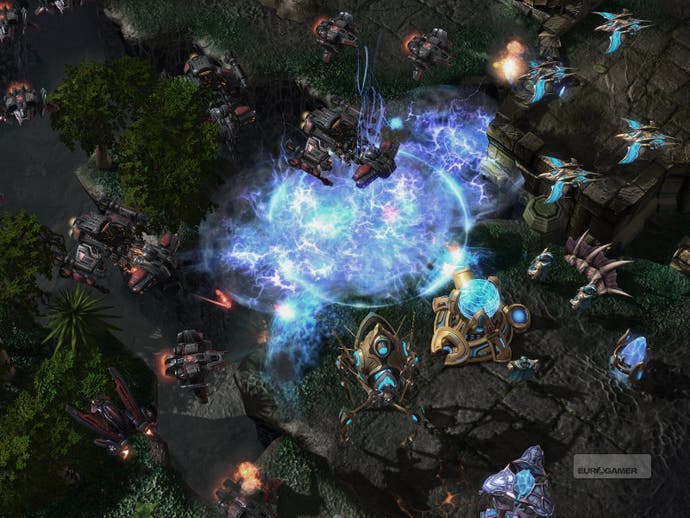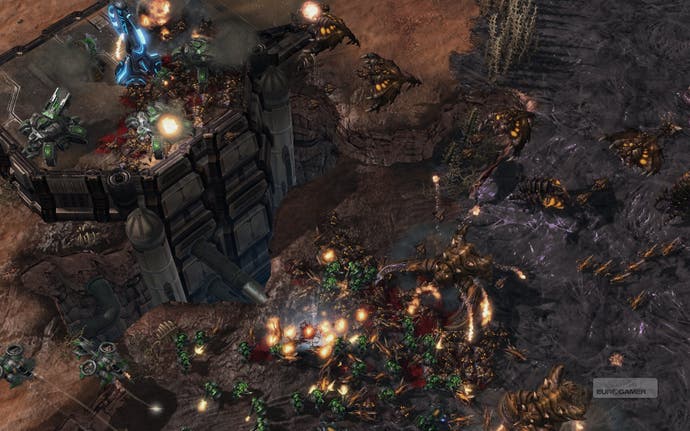StarCraft II
Terran up the competition: the beta, previewed
It's probably not deliberate, but Blizzard seems determined to drive home just how inadequate I am as a gamer. Within minutes of arriving at the company's imposing Southern California base - the giant statue of an orc riding a wolf in the courtyard is under renovation by a team of builders, it transpires - I'm seated in a private cinema to watch some StarCraft II matches in progress.
Observing the matches through the game's vastly improved spectator mode, ably assisted by a live commentator, I watch the balance of power and resources ebb and flow at breakneck speed. StarCraft has always been a fast game, and StarCraft II has lost none of that speed. With two experienced players pitted against one another, the game is all about broad strategy and perfect timing.
They expertly probe one another's defences for any way to gain a resource advantage, distracting one another with feints and taking calculated risks where the balance between stunning victory and crushing defeat rests on a knife-edge. Tiny turns in the balance of play can determine the fate of a match - easily missed by less experienced eyes, were it not for the helpful voice of our commentator. Even the physical dexterity of the players is mind-boggling, with graphs on screen showing that each is carrying out well over a hundred actions per minute.
This is impressive stuff - but also a little intimidating. This kind of play is probably beyond the reach of mere mortals such as I. It's hugely entertaining to watch, but can it possibly be fun to play for a less talented and devoted gamer? Is this really a game for all of us, or should those of us who aren't Korean youths dreaming of pro-gamer careers look away now?
"Okay", our Blizzard hosts say, with a hint of a slightly evil grin. "Now it's your turn!" Time to find out.
Even back in 2003, when work started on StarCraft II, it was obvious that this game was a child of two worlds. On one hand, millions of gamers has bought the game and loved it - finding joy in the extraordinarily perfect balance between the three disparate forces, the surprisingly strong narrative of the singleplayer mode and the fast-paced, action-packed nature of multiplayer encounters.

On the other hand, however, the world of eSports had picked up StarCraft with an enthusiasm few other games have enjoyed. Professional players invented ingenious strategic tricks and pushed their physical abilities to levels which shocked even the game's creators at Blizzard. In Korea and other East Asian nations, TV broadcasts of StarCraft pro matches were filmed in front of studio audiences largely made up of teenage girls who screamed the names of their pro-gamer idols.
With StarCraft II, the challenge is to try and please both of those audiences. Blizzard wants the pro gamers to love StarCraft II, but it wants you and I to love it just as much. It's a tall order, but the company adopted a handful of design ideas which, it reckons, will ensure that StarCraft II makes everyone happy.
The first, and perhaps most important, of those ideas is apparent to me within minutes of settling into my first game. StarCraft II has totally avoided the trap into which almost every other RTS sequel in gaming history has fallen - namely, making the sequel more complex than the original.

The temptation, with a sequel, is to put everything from the first game in, and add extra stuff on top of that. Instead, StarCraft II re-imagines the three races - but doesn't make them any more complex than they were before, and resists the urge to add a fourth race to the mix.
Blizzard's head of game design, Rob Pardo, is very blunt about how this design idea worked in practice. In StarCraft: Brood War, each race had around 15 units to play with, a number which the team decided to stick to. The consequences were obvious. "We had a rule that every time we wanted to come up with a brand new unit for one of the sides, an old unit had to go," Pardo explains.
"We really felt like the original StarCraft had the right mix of complexity," he continues. "It had a lot of depth and complexity to it, but it was still really approachable and accessible. If the approach we took was just to take a whole bunch of new units and throw them in there, we felt like the game was just going to become overly complex, and wouldn't even be as good as the original."
A similar philosophy has been applied to the buildings and research trees in the game. What I'm confronted with when I sit down to play StarCraft II is a game which is familiar from my years of playing StarCraft (badly), but yet different in almost every way. Some key ideas are familiar - resources and scouting are still crucial, as is knowing when to build an expansion. The basic play-style of each race remains the same.








